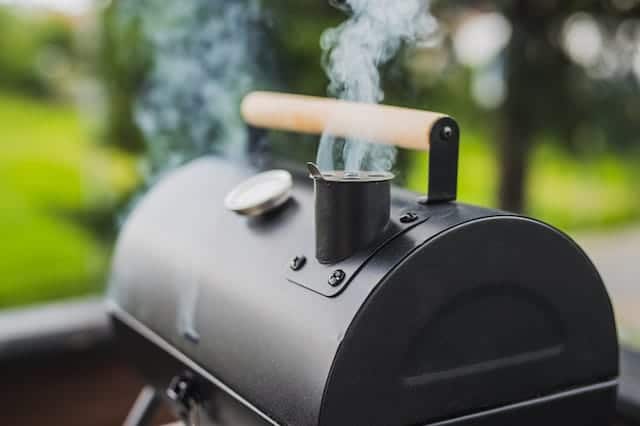Are you experiencing unusual smoke leakage from your barbeque smoker? Whether you’re new to the world of smokers or you’ve used smokers for years, experiencing low or excessive amounts of smoke can be a frustrating experience. In order for a solution to be found, it’s important to understand how much smoke should be coming out of your smoker.
All smokers must release some amount of smoke in order to function. Generally, you should see thin whips of blue smoke coming out of the grill. If smoke is rolling out of the sides and seals, there is an issue with the smoker. Too much smoke will cause the food to lose its tender, smoky flavor.
Without smoke, smokers would be unable to produce the flavorful smoke necessary for grilling food. However, too much smoke can be just as much of an issue as too little smoke. If you’re unsure how to solve abnormal smoke leakage, you have come to the right place. Today, we’ll explain everything you need to know about how much smoke is normal in smokers and how to prevent common smoke issues.
How Much Smoke Should a Smoker Produce?
Smoke is a necessary element for grilling on a smoker. Because too little smoke will give the food a bitter taste, it is essential for smoke to be released during the smoking process. However, there may come a point when too much smoke is escaping from your smoker. To solve this issue, you must first understand how much smoke a smoker should produce.
In general, a smoker should produce thin whips of blue smoke. If your smoker is producing billows of gray smoke, you may need to adjust the damper of your smoker. Similarly, too little smoke is a common issue that requires immediate attention to prevent food from becoming smokey.
When you first fire up your smoker, you may notice gray-color smoke being released. Following this gray smoke will be the transparent blue smoke necessary for smoking food. Avoid putting food in your smoker until the smoker produces this thin blue smoke.
If your smoker isn’t producing enough smoke, stale smoke will occur. Stale smoke is the result of improper airflow in smokers. When a smoker’s ventilation becomes blocked, the smoke will be unable to escape the smoker. As a result, any food inside the smoker will become black from the bitter creosote.
While it is often thought that more smoke is better, too much smoke can be just as much of an issue as too little smoke. Because excessive amounts of smoke can cause food to lose its tender, smoky flavor, a smoker’s smoke should always be a thin blue color. Never should a smoker be producing billows of thick white smoke.
How to Solve Too Much Smoke in a Smoker
If your smoker is producing excessive amounts of smoke, it’s important to solve the issue immediately. Heavy smoke will not only pollute your entire backyard, but it will coat your meal with a crusty, black layer. Fortunately, there are many ways to prevent billows of white smoke from leaking out of your smoker. Here, let’s take a closer look at how to prevent heavy smoke leakage in smokers.
Use Dry Wood
When cooking on your smoker, it’s important to start a fire only with dry, seasoned wood. Green or wet wood will retain moisture and consequently hinder ignition. As a result, your smoker will produce thick white smoke rather than thin whips of blue smoke.
Although it is often said that wood should be soaked in water for 24 hours prior to use, soaking the wood may affect the quality of the smoke. The purpose of soaking wood in water is to slow combustion and lower the smoker’s temperature. Unfortunately, soaking wood chips or pellets in water may cause excessive amounts of smoke due to the inconsistency of the smoker’s temperature. For best results, it is best not to soak wood chips before use.
Build a Coal Bed
Before adding wood or pellets to your smoker, it is recommended to build a coal bed. By allowing a bed of hot coals to develop, the smoker will maintain an even temperature. As a result, the smoker will produce a steady flow of thin blue smoke.
Manage the Smoker’s Airflow
Oftentimes, smokers will leak heavy smoke when there is improper airflow. Because every smoker is designed differently, it’s important to monitor the smoke your smoker is producing to determine if it has enough airflow.
To promote proper airflow, keep the exhaust of the smoker open. If the wood is burning too quickly, you may need to adjust the dampers. The wood should burn steadily without producing too much or too little smoke.
Use Your Smoker More Frequently
In some cases, a smoker will produce heavy smoke because it lacks a layer of carbon. This is a common issue with brand new smokers with smooth, clean finishes. To prevent heavy smoke leakage, you’ll need to use your smoker as frequently as possible. This will allow carbon to form on the surface, which ultimately prevents smoke from escaping.
How to Solve Too Little Smoke in a Smoker
There are a number of reasons your smoker may not be producing as much smoke as you expected. The amount of wood, poor ventilation, and ashes in the firepot are all factors that can cause a smoker to not create enough smoke. Fortunately, each one of these issues can easily be solved. Below, let’s take a closer look at how to solve too little smoke in a smoker.
Use the Right Amount of Wood
The key to steady blue smoke in a smoker is using the right amount of wood or pellets. Generally, you’ll need two or three chunks of wood to start with. Before adding the wood, make sure you build a coal bed in the smoker. This will keep the temperature consistent to promote thin blue smoke.
Additionally, make sure you are only using dry wood. Avoid using greenwood or soaking wood prior to use. Although soaking wood in water may keep the temperatures consistent, it can also prevent the fire from burning. For best results, use a small amount of dry wood and adjust as needed.
Adjust the Damper
Another reason your smoker may not be producing enough smoke is that the damper needs to be adjusted. Most types of smokers will have a damper on the top and bottom of the smoker. Generally, the top damper should be open while the bottom damper should be closed. This will increase the airflow while improving the smoke quality. Keep in mind that you may need to adjust the damper as you grill to ensure enough smoke is being released.
Clean the Firepot
The final solution for creating more smoke in your smoker is to clean the firepot. When the firepot is filled with ashes, your smoker may not produce enough smoke. To clean the firepot, simply remove the heat shield and scoop out the ashes.
Getting your smoker to produce a steady amount of thin blue smoke should not be a difficult process. By following these simple tips, you can ensure your smoker’s smoke will remain consistent throughout the entire barbeque season.
Keep reading: How to Season a Smoker – Follow These Steps
Scot has loved smoking food in his free time for the last few years. Each major holiday or off-weekend, Scot spends days testing and prepping new recipes for perfection.

